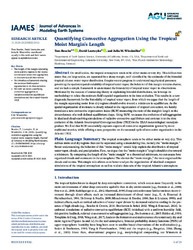Quantifying Convective Aggregation Using the Tropical Moist Margin's Length
DOI: https://doi.org/10.1029/2020MS002092
Persistent URL: http://resolver.sub.uni-goettingen.de/purl?gldocs-11858/9446
Persistent URL: http://resolver.sub.uni-goettingen.de/purl?gldocs-11858/9446
Beucler, Tom; Leutwyler, David; Windmiller, Julia M., 2020: Quantifying Convective Aggregation Using the Tropical Moist Margin's Length. In: Journal of Advances in Modeling Earth Systems, Band 12, 10, DOI: 10.1029/2020MS002092.
 |
Dokument öffnen: |
On small scales, the tropical atmosphere tends to be either moist or very dry. This defines two states that, on large scales, are separated by a sharp margin, well identified by the antimode of the bimodal tropical column water vapor distribution. Despite recent progress in understanding physical processes governing the spatiotemporal variability of tropical water vapor, the behavior of this margin remains elusive, and we lack a simple framework to understand the bimodality of tropical water vapor in observations. Motivated by the success of coarsening theory in explaining bimodal distributions, we leverage its methodology to relate the moisture field's spatial organization to its time evolution. This results in a new diagnostic framework for the bimodality of tropical water vapor, from which we argue that the length of the margin separating moist from dry regions should evolve toward a minimum in equilibrium. As the spatial organization of moisture is closely related to the organization of tropical convection, we hereby introduce a new convective organization index (BLW) measuring the ratio of the margin's length to the circumference of a well-defined equilibrium shape. Using BLW, we assess the evolution of self-aggregation in idealized cloud-resolving simulations of radiative-convective equilibrium and contrast it to the time evolution of the Atlantic Intertropical Convergence Zone (ITCZ) in the ERA5 meteorological reanalysis product. We find that BLW successfully captures aspects of convective organization ignored by more traditional metrics, while offering a new perspective on the seasonal cycle of convective organization in the Atlantic ITCZ.
Statistik:
ZugriffsstatistikSammlung:
This is an open access article under the terms of the Creative Commons Attribution-NonCommercial License, which permits use, distribution and reproduction in any medium, provided the original work is properly cited and is not used for commercial purposes.

